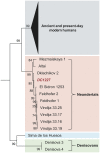Identification of a new hominin bone from Denisova Cave, Siberia using collagen fingerprinting and mitochondrial DNA analysis
- PMID: 27020421
- PMCID: PMC4810434
- DOI: 10.1038/srep23559
Identification of a new hominin bone from Denisova Cave, Siberia using collagen fingerprinting and mitochondrial DNA analysis
Abstract
DNA sequencing has revolutionised our understanding of archaic humans during the Middle and Upper Palaeolithic. Unfortunately, while many Palaeolithic sites contain large numbers of bones, the majority of these lack the diagnostic features necessary for traditional morphological identification. As a result the recovery of Pleistocene-age human remains is extremely rare. To circumvent this problem we have applied a method of collagen fingerprinting to more than 2000 fragmented bones from the site of Denisova Cave, Russia, in order to facilitate the discovery of human remains. As a result of our analysis a single hominin bone (Denisova 11) was identified, supported through in-depth peptide sequencing analysis, and found to carry mitochondrial DNA of the Neandertal type. Subsequent radiocarbon dating revealed the bone to be >50,000 years old. Here we demonstrate the huge potential collagen fingerprinting has for identifying hominin remains in highly fragmentary archaeological assemblages, improving the resources available for wider studies into human evolution.
Figures




References
-
- Bolikhovskaya N. S. & Shunkov M. V. Pleistocene environments of northwestern Altai: Vegetation and climate. Arch. Ethno. Anthr. Eurasia 42, 2–17 (2014).
-
- Agadjanian A. K. The dynamics of bioresources and activity of the Palaeolithic man, using the example of northwestern altai mountains. Palaeontolog. J. 40, S482–S493 (2005).
Publication types
MeSH terms
Substances
Supplementary concepts
LinkOut - more resources
Full Text Sources
Other Literature Sources
Research Materials

